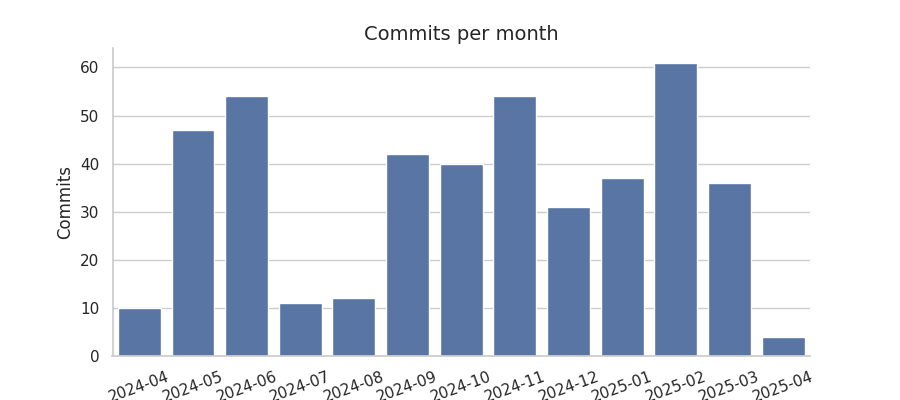We try to provide as much as possible exportable artefacts that can easily be reused in external resources. This section describes how to get them, and the naming convention used to produce these artefacts. Unless otherwise stated, they are deemed stable.
Endpoint for charts
https://metrics.eclipse.org/images/projects/<project_id>_<chart_type>.pngWhere:
<project_id>is an Eclipse project ID, e.g.technology.dash.<chart_type>is one ofcommitsorissues.
The activity plots are generated using Seaborn . Almost all charts are saved with this syntax, which makes them persistent and easy to reuse. Note that in most cases, you can can simply reuse the image URL as the source on the external page.
When using Markdown, you can use a line like this to show the commits plot for Eclipse Kuksa:

When using pure HTML, use a line like this:
<img alt="Commits per month for <project_name>" style="width:80%" src="https://metrics.eclipse.org/images/projects/<project_id>_commits.png" />
Using Markdown:

Using pure HTML:
<img alt="Commits per month for Eclipse Kuksa" style="width:80%" src="https://metrics.eclipse.org/images/projects/automotive.kuksa_commits.png" />
Both syntax produce the following image:

Endpoint for CSV files
https://metrics.eclipse.org/csv/projects/<project_id>_<type>.csvWhere:
<project_id>is an Eclipse project ID, e.g.technology.dash.<type>is one ofcommits,issues,reviewsoriplab.
CSV files can also be downloaded from the project or working group pages. File includes headers, which make them easy to import in any BI tool (e.g. spreadsheets, or dedicated data visualisation products) or in any programming language (e.g. Python and Pandas dataframes).
Importing the list of commits for project Eclipse Kuksa into a dataframe:
$ python
Python 3.11.7 (main, Dec 4 2023, 18:10:11) [Clang 15.0.0 (clang-1500.1.0.2.5)] on darwin
Type "help", "copyright", "credits" or "license" for more information.
>>> import pandas as pd
>>> commits_kuksa = pd.read_csv("automotive.kuksa_commits.csv")
>>> commits_kuksa.head()
Unnamed: 0 hash_long hash_short ... files created_at
0 1274 661b203a153e5298e93fd1cc927e16c8dbcade6d 661b20 ... 4 2023-02-09 12:39:30
1 1275 3c8dbb148d67bd81d0ca13cf8edfbe311b57a270 3c8dbb ... 4 2023-02-09 12:39:30
2 1409 b01698fa045dc3749d03f06e59859c0f869dfd17 b01698 ... 4 2023-02-09 15:13:29
3 1422 bfc9caa3feb692cecbff84c418fe9a0aba837269 bfc9ca ... 1 2023-02-09 15:29:16
4 1528 e87603ded36e0449195862bd3a692362f7856264 e87603 ... 1 2023-02-09 17:50:02
[5 rows x 15 columns]
Endpoint for SDV Badges
https://metrics.eclipse.org/badges/<project_id>[_<component>]_badge_<badge_type>.pngWhere
<project_id>is the ID of the project, e.g. automotive.ankaios<component>is the component ID, or name of the repository, e.g. up-rust for Eclipse uProtocol. For projects that don’t have components defined, the component name is the name of the project, e.g. ankaios for Eclipse Ankaios.<badge_type>is a maturity assessment criterion, one ofdocumentation,coding_guidelines,oss_best_practices,release_process,testing,requirements, orintegration.
SDV badges are only available for projects who chose to enter the SDV Maturity assessment program. The badges can be checked in the “SDV Maturity Assessment” tab of projects.
The following code:

Produces the following image:

The following code:

Produces the following image:
